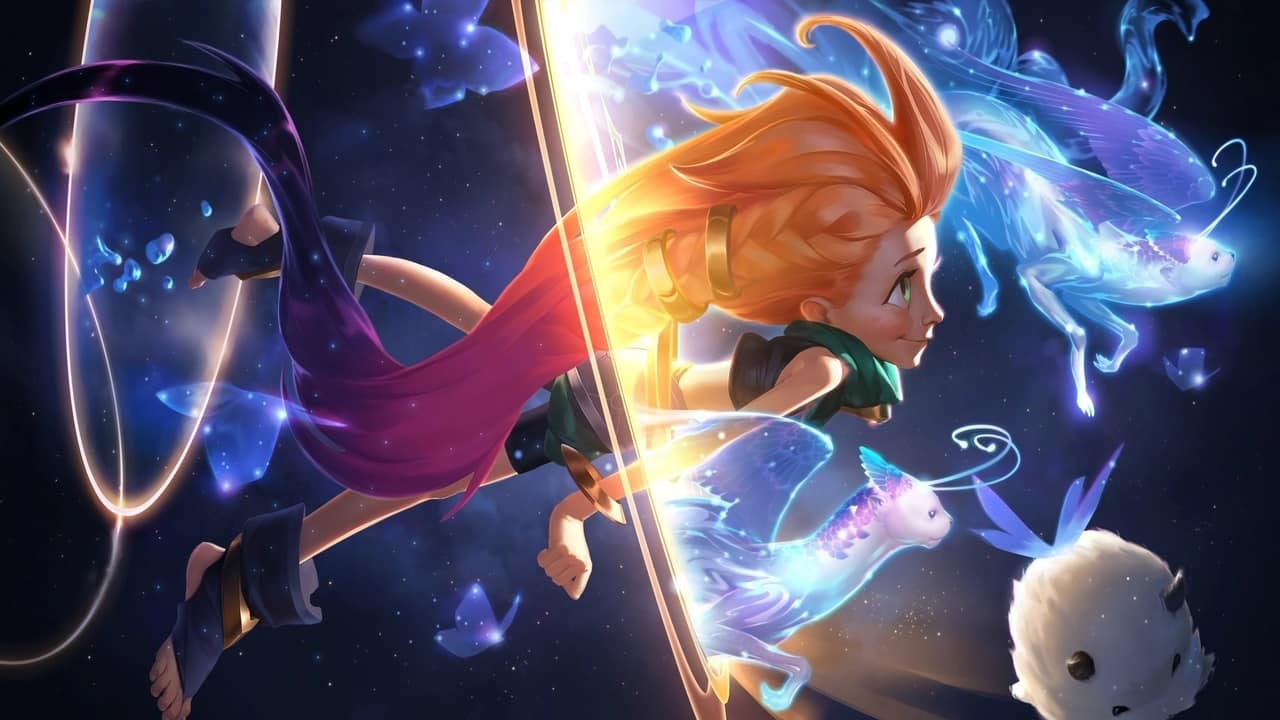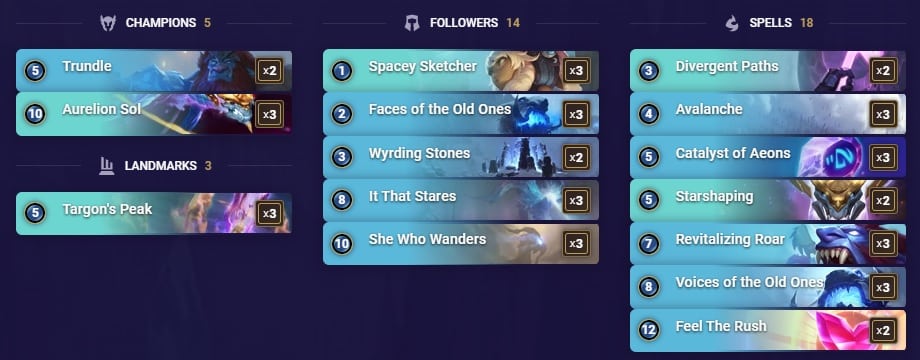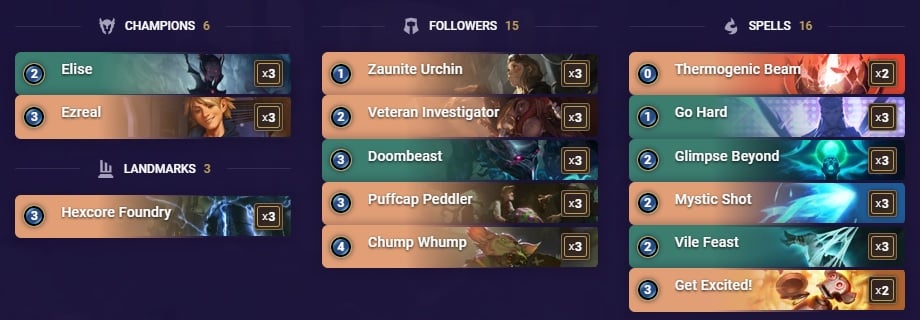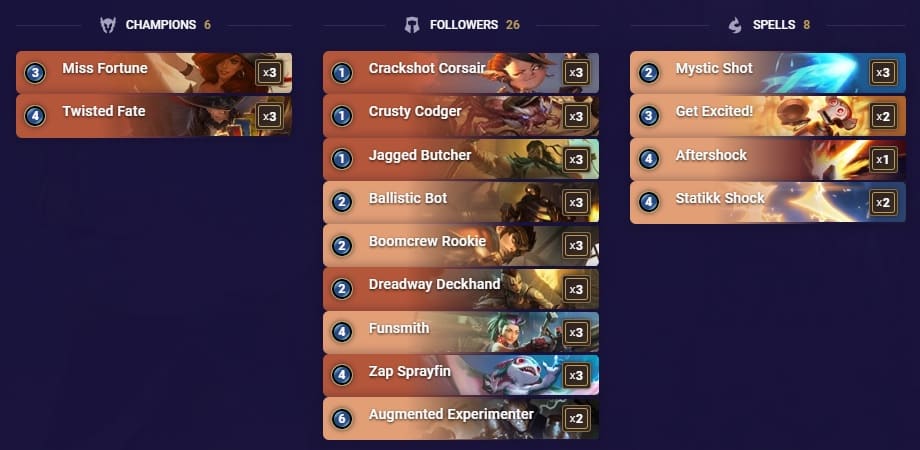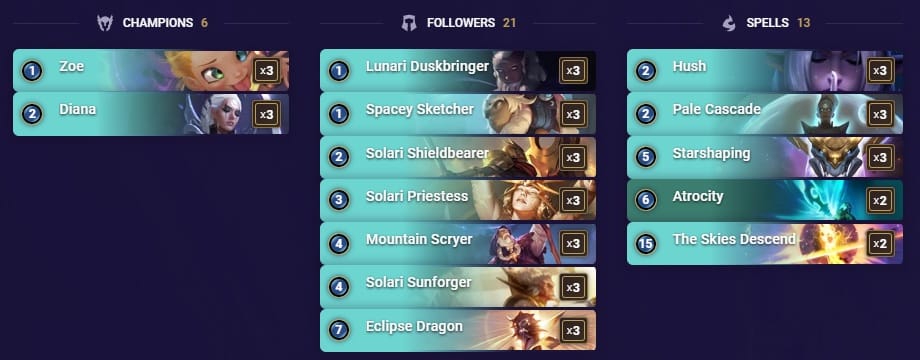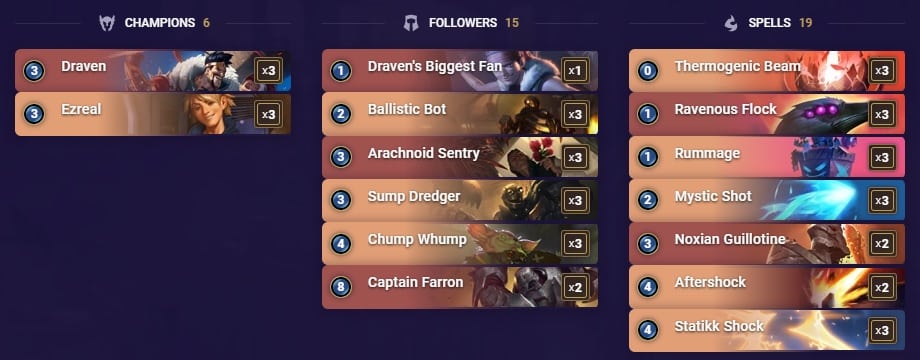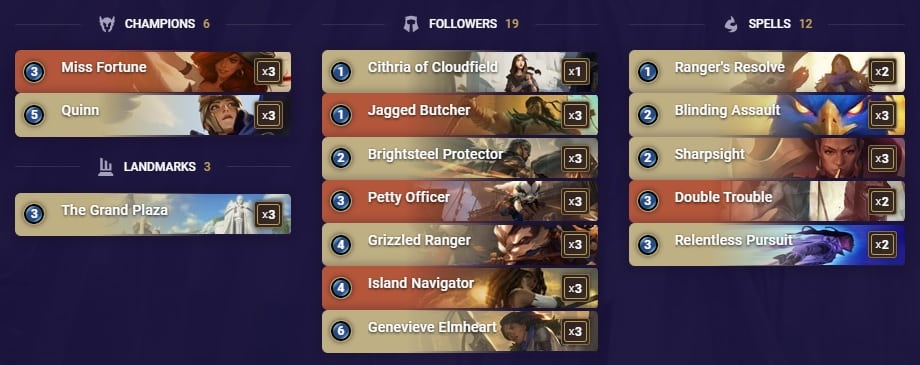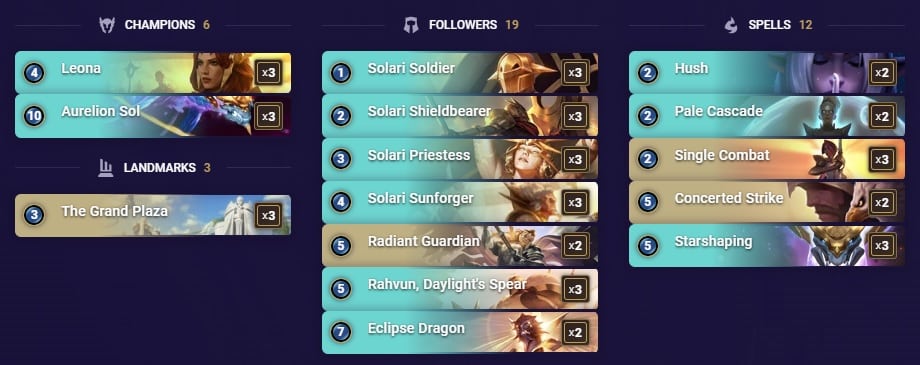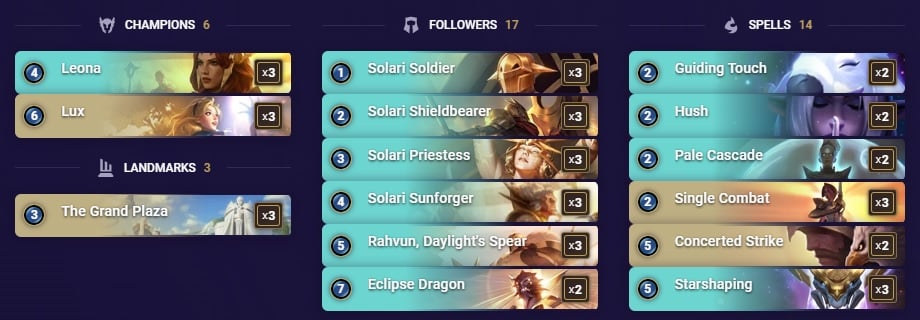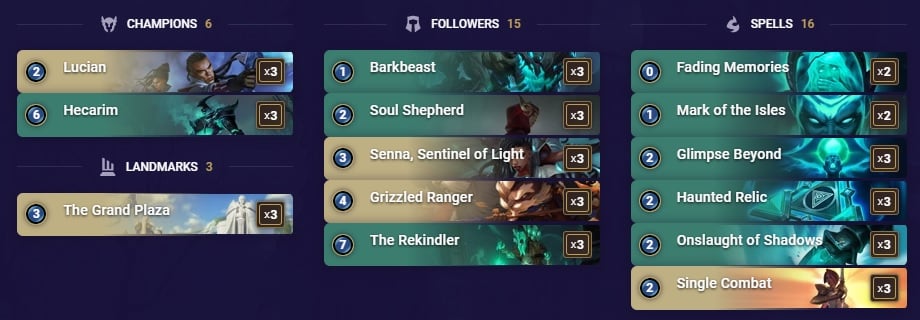Welcome everyone! We will now release our meta snapshot on Mondays instead of Sundays, as many of our players are active in tournaments throughout the weekend. This gives us more time to provide the best snapshot we can.
Speaking of the snapshot, this week we will be doing something slightly different. The meta needs time to settle and so, to tide you over, we have 8 new decks for you to try (along with a refined version of Ezreal-Draven). We endeavoured to provide new decks only, so meta mainstays like Go Hard Twisted Fate are absent from this list. Next week, we’ll resume rating the decks.
We also want to congratulate our writer Den for being LoR’s first Monuments of Power Europe champion, as well as to welcome Pespscola, the winner of the LoR Masters Europe with Portugal, to our team.
If you have any questions, feel free to drop by our Discord. Best of luck on your climb!
Editing: Wusubi, Sebodunum
Writing: CastMin, Crixuz, Den, Pespscola, RattingBones, Ultraman
Table of Contents
Targon’s Peak
CIBQGAIBBQKDIAYDBFAFMVYEAMAQGBAKCMBQCAIBEEBAGAIGCYBAGCIFKQAA
Targon’s Peak (ASol-Trundle) is an extremely greedy deck that wants to cheat out big, beefy units like ASol, Feel The Rush and She Who Wanders by Turn 5-6.
The deck has two main game plans: (1) Stabilize first, or (2) Targon’s Peak first.
(1) Against Aggro decks, playing Targon’s Peak on Turn 5 is usually a losing play due to the loss of tempo. To mitigate this, you have to ensure that your tempo is equal to your opponent’s before committing to Targon’s Peak. One way of doing this is by making plays in the early game that result in a tempo swing in your favor. For example, Turn 1 Spacey Sketcher often means you have two units versus your opponent only having one unit.
By making plays like this to ensure that you have the tempo advantage prior to Turn 5, you can play Targon’s Peak without losing the board. A more moderate position would be to play Avalanche. While it does tap you out of mana and allows the opponent to develop, they usually don’t have the resources to play too many units. For this game plan, it’s usually good to mulligan away your ramping tools because they’re by definition “tempo-reducing” for the player.
(2) The second game plan can be applied when you don’t care about tempo in the early game. This applies to matchups that are slower such as control decks (e.g. FTR) or even some Plaza decks. The idea is that since no combination of cards they can play in the first 3-4 turns can bring down your Nexus health significantly, you can wait to play Targon’s Peak and outvalue your opponent. In this game plan, you want to ramp. You also want to mulligan for your landmark.
Is this deck any good? Targon’s Peak is a card that has a bilateral effect. This means that it doesn’t only reduce a random card of yours to zero, it does the same for your opponent as well. A second problem is that its effect is random. This means that very unfavourable situations can arise, such as your opponent’s Ledros and Atrocity being reduced to zero, while you only have Spacey Sketcher and Wyrding Stones reduced. For this reason alone, this deck can never be truly competitive.
However, LoR is a skill-intensive game and there can be ways to mitigate this. Spacey Sketcher serves a dual function here; it not only nets you the tempo advantage in the early game, but it also acts as a hand correction tool. Clearly, it’s crucial to play your low cost cards out before you drop your landmark in order to maximize the chance of it hitting something good.
In conclusion, Targon’s Peak is a blast to play and everyone should try it at least once, but we wouldn’t necessarily advise using this deck to climb the ladder. (Write-up by Crixuz, deck by Swim)
Hexcore Puffcaps
CICQCAQEBIAQGBAUAIBQKBQQAMAQKKBRGUCQCBAZEQWTIOQBAIAQIGZHAA
With the release of the Hexcore Foundry landmark, for the first time, the concept of milling your opponent with Puffcaps has found a competitive deck. The best way to abuse the landmark is to play a low curve, because most decks usually play around 1 to 2 cards per turn. That way, you end up playing your hand more efficiently than your opponent, therefore the card draw from Hexcore Foundry will benefit you more than your opponent.
Other factors that make this landmark decent are Go Hard and Puffcaps. Firstly, the draw provided by Hexcore Foundry helps you find more of your Go Hards in a faster and more efficient manner. Secondly, by stuffing your opponent’s deck with Puffcaps, the draw on their side will be burning their Nexus down. So, while Hexcore Foundry may not have seemed like a powerful card at first glance, in this deck its potential value shouldn’t be underestimated.
In essence, then, this is a mill deck that focuses on burning the opponent’s Nexus. (Write-up by Pespscola)
Funsmith Burn
CICACAYGB4AQGBAFAMAQIMZUGYDAEBQECYNCMOR4AEBQCBAND4TQCAIDAQFQ
With all the boring The Grand Plaza builds running around, do you actually want to have fun? Do you love chipping your opponent down, but are bored of how obnoxious Go Hard Twisted Fate is? Well, then, Funsmith might be the way for you, my friend. The concept behind this is pretty simple: you want to sneak damage past your opponent turn by turn, even if they have blockers available for themselves. That’s the purpose of most cards in this deck.
The general game plan is: (1) Mulligan for your 1-drops to find your early curve. (2) Develop at your own discretion until the mid game, then you need to bear in mind that developing may mean a blocker that gets a favourable trade on your units. (3) Switch to Burn and blocking mid to late game to finish your opponent off.
(4) Be comfortable blocking just the bare minimum needed to stay alive instead of using Burn to clear mid to late game. Health is a resource in this deck, so going low isn’t an issue, if it means you can kill your opponent. (5) Don’t be scared of healing, since most of the time you can out-damage anyway. (Write-up by CastMin)
Zoe-Diana
CEAQYAYJBEOCGOBZJFGFIVKWMBSAEAIBAUMQCAYJAIAA
Targon Allegiance has been an archetype since the release of Call of the Mountain, it had a lot of variants, but the one with recent success was Leona-Diana with an Atrocity. This deck is very similar to Leona-Diana, the major difference being Zoe replacing Leona. Why has that happened? Well, Leona became an easy cut with the release of Solari Sunforger.
Why is Zoe good? Zoe is a value engine that forces answers which, in most cases, trade down in mana. One Nexus strike from Zoe is already super valuable, because your deck synergizes well with your cards in such forms as the discount from Mountain Scryer, the discount on The Skies Descend and Zoe’s creation of Behold the Infinite (in her flipped form) to gain access to expensive Invoke spells and thereby make the apex Invoke units stronger when they’re summoned.
To give a short overview of the key cards: Mountain Scryer is the best value engine in the deck, The Skies Descend can give you the edge vs Midrange and Atrocity provides a bit more reach. (Write-up by Pespscola)
Ezreal-Draven
CICACAQDBEAQGBAFAIAQGFBOA4AQIAI3D4SCMNB2AIAQGBALAIAQGFRTAEAQCAZD
Ezreal-Draven is a Midrange deck with a plethora of answers against any matchup. Precise mulligans and good line-up theory (which answers go onto which threats) is essential for this deck to work well.
In this version, Tri-Beam Improbulator is dropped in order to gain the ability to mulligan more flexibly. In decks that run three copies of Tri-Beam, the mulligan is fixed; you’re obligated to keep Tri-Beam in your opening hand. This is certainly not a huge problem, since Tri-Beam is such a strong card, but here we have gone in a different direction.
The goal of the deck is to play Draven on Turn 3 to create Spinning Axes to generate a card advantage over the opponent. The rationale is that if you trade cards 1-for-1 (this can be either spells or units), eventually your opponent will run out of things to play while you still have juice in the tank due to the ability to trade discard fodder for actual cards.
At the same time, you should be looking to deal chip damage to your opponent every turn, starting from Turn 3. Draven has quick attack, which means he’s always going to be unchallenged during your attacking turns (until your opponent starts playing units with health greater than 3, which sometimes can be quite late into the game). Another way to deal chip damage is via a wide board or Ezreal’s Elusive keyword.
Once you’ve transitioned into the late game, Captain Farron or a levelled Ezreal will close out games for you. Be careful when you play Farron, as he’s usually a tempo-reducing play given his 8 mana cost. Mana is necessary for reactivity and unless it’s (a) safe, (b) you have mana banked, or (c) it’s a winning play, don’t feel obligated to drop the Farron as soon as you hit Turn 8. (Write-up by Crixuz, deck by Ultraman)
Scouts Plaza
CICACAIABEBAGAAKBYCAEBQICY5D4BACAABAMCIKAMAQCAAVAEBAMGABAIAAOAIBAEACO
Scouts were a good deck not so long ago. It’s great early game and trading capacity usually led the deck to advantageous positions it could leverage to level-up Miss Fortune and push for a lot of damage. The archetype lost a lot of relative power, though, when Go Hard and Ezreal-Draven, two very good decks at slowing down board-centric decks, rose to popularity.
With the addition of The Grand Plaza, your followers now not only get bigger by +1/+1, they also receive the Challenger tag. This means that every single unit decides which trade it takes, making it much harder for the other decks to set-up good situations for their spells to be as effective as they have been previously.
Because of that, we’re seeing a huge comeback of the Scouts archetype, and The Grand Plaza looks like it will finally settle the “Bannerman or no Bannerman” debate, as the release of this landmark has allowed a much heavier Bilgewater core than Bannerman could ever allow.
The summoning units from Bilgewater (Petty Officer, Island Navigator or even the new addition of Double Trouble) have a perfect synergy with The Grand Plaza and allow the deck to fill the board quickly as well as giving Miss Fortune and Quinn tons of minions to send to battle and help them level-up.
Whether the deck will follow the same path as last patch remains to be seen; ultimately, it will be up to the other popular archetypes to decide that. But Scouts are definitely a deck on the rise this week and a ladder deck of choice for a lot of players missing an aggressive, board-centric deck. (Write-up by Den)
Leona-ASol
CIBQCAIADIAQGAAKBABQSGQ4GY4VIV2YMABQCAIAB4AQEAABAMBQSI2VMQAA
The party is well and truly on at the Plaza this week, but this particular iteration takes a different approach by using the landmark as a defensive tool. While most decks use it mainly for trades, this one relies on the extra healing provided by Solari Sunforger in order to survive the early game. The great curve leads to some comeback potential, especially with Plaza in play. Single Combat and Sunforger have the capacity to heal up to 12 HP on an offensive Turn 4, for example.
They say the best defense is a good offense, and it has never been more true. If you somehow still end up behind, you’ll have to rely on Radiant Guardian and Concerted Strike to regain the board and reduce the opponent’s damage output.
Early Solari followers will help you avoid falling behind too much in the games where you don’t find Plaza or Sunforger, while Starshaping can be used as a last resort to avoid certain death. It must be said that due to the vast loss in tempo that Starshaping represents, you don’t want to use it until you have taken the board back, so keep it as a way to survive, but don’t rely on the healing until you’re strong enough to absorb your opponent’s next move.
Finally, while Leona and the tempo of your value trades could lead to a victory in the end, you’ll still be relying on ASol to close out most control games, as your damage potential remains low and you’re exposing yourself to hard removals and AoEs (cards like Pack Your Bags or The Ruination). Drop the massive dragon and watch them tremble in fear of your own powerful removals and created Celestial Elusives! (Write-up by Ultraman)
Leona-Lux
CEBQOAYJDIODMOKULBQAEAIADIVACAYABIBAIAYJEMZVKZABAIAACAA
Leona-Lux used to be a Tier 2 deck when Targon got released. The biggest issue it had was its inability to play proactively and finish games quickly. It’s worth mentioning that what it lacked in offense, it made up in defense. Daybreaks would give you big buffs, allowing you to prevent your opponents from attacking optimally. Furthermore, you had cards like Radiant Guardian and Starshaping that would each grant you 4/5 health. All in all, a very grindy but solid deck.
Now we got The Grand Plaza and Solari Sunforger. Both of these cards changed the deck dramatically. No longer do we have to play defensively and grind a win. Now, we can proactively challenge units with The Grand Plaza, allowing our high stat units to effectively fight for the board! Not only can we fight for the board and deal with problematic units/champions like Twisted Fate, but we can heal for 30+ health per game. Your opponents will love you. (Write-up by RattlingBones)
Lucian-Hecarim
CICQCAQABEAQEBIGAEBQACQDAEABMGRGAYAQKBYKCQLSUMIBAIAQKFRPAA
The Ephemeral keyword didn’t really have a home for a while. Although the whole mechanic has efficient support cards (Fading Memories, Soul Shepherd) and also has several champions benefiting from it (Lucian, Kalista, Hecarim), it has never really clicked. Now, though, it looks like the time has come for the undead to be back as a dominant archetype thanks to the new landmark: The Grand Plaza.
The problem with Ephemeral followers has always been their volatility, the keyword not allowing the player to establish a board presence from one turn to another and therefore falling behind in the mid game. Now that The Grand Plaza allows the followers to get the Challenger tag, the Ephemeral tag isn’t so much of a problem and the deck can control the board until the Ephemeral synergy builds up and takes over the game.
With the looks of an aggressive deck trying to go all-in, the deck actually builds toward a huge Hecarim when the early pressure doesn’t work and its strongest turns usually are in the 5-8 range. If the opponent cannot keep up, then Lucian has all the support he needs to evolve (Senna, Single Combat) and allows you to attack multiple times for great damage.
There are tons of lists emerging for this archetype and it’s still up for debate which will be the best 40 cards for the deck. Moreover, landmark removal may also come back in the meta eventually, which would greatly reduce the deck’s power. Until then, Lucian-Hecarim looks to be one of the high profile decks on the ladder for players liking pressure-oriented gameplay with a slight touch of combo sprinkled on it for good measure. (Write-up by Den)

